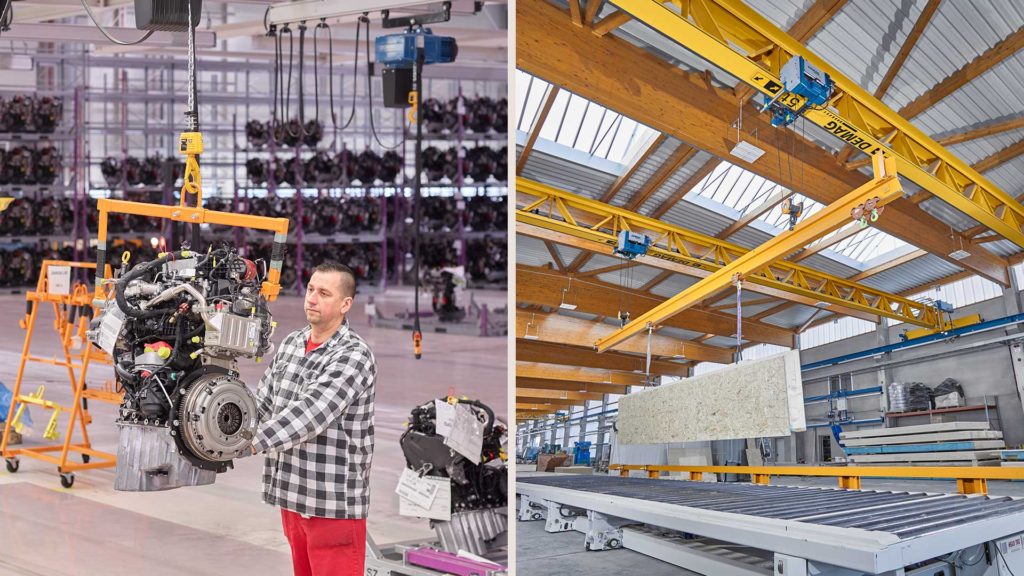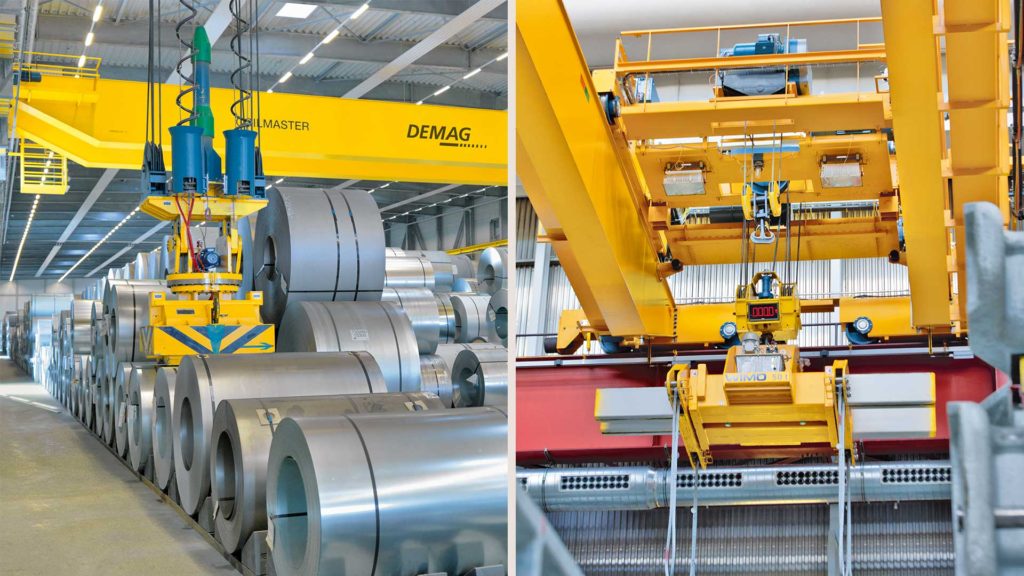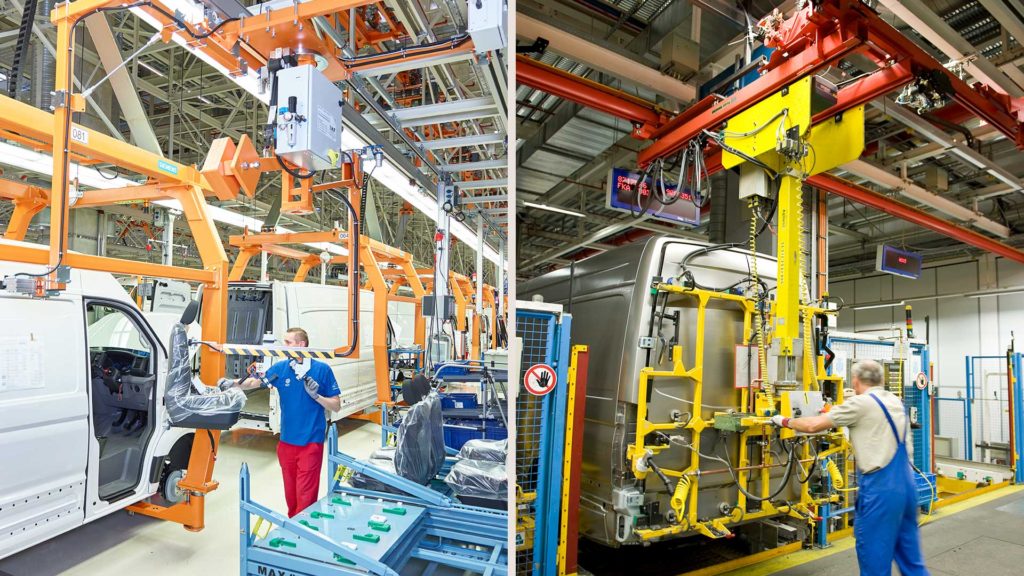No matter if the load is light or heavy, below the hook attachments and end effectors are what help make the job more efficient and help make an operator’s job safer. These specialized tools are tailored to become the hands of the crane and help the operator do a job more efficiently and precisely. We are going to talk about some of the options available for below the hook attachments and end effectors on the market.
Below the hook attachments usually refer to devices that suspend the load from the hook of the crane and are designed to attach the load in the most safe, secure and efficient way possible. There are many pre-engineered attachments available or the attachments can be a completely custom attachment specially engineered for the job. In either case, these can be purchased from a crane manufacturer or from a crane dealer who specializes in these custom solutions.
Below the hook attachments that suspend from the hook of the hoist are best suited when you need multiple attachments to pick up multiple loads, allowing the attachments to be quickly changed out to efficiently handle the load. When your crane and hoist is lifting a single load, or you can use the same attachment for multiple steps of the process, a more permanent connection to the hoist rope or chain can be considered. As a bonus, it can also increase the lift height available to the crane.

Below the hook attachments can be manual or powered. There are many below the hook attachments that don’t need any power run to them, for instance when slings, chains, pantographs, or c-hooks are being used to lift a load. When the attachment is powered, a cable reel or coil cable/ hose is connected to the hoist trolley so the power can be delivered to the device. The powered device normally has a control to open or close and rotate clockwise or counterclockwise.
Depending on your industry, sometimes you need devices and products that can take high heat, humidity or welding environments. There are many standard, off-the-shelf solutions out there to meet your needs, and when there isn’t, a custom design is possible through a crane dealer or crane manufacturer.
Manual Below the Hook Attachments

Manual below the hook attachments are not powered. These attachments hang off the hook to do a job. Lifting beams are common when the item that you need to lift is long. They attach to the hooks of one or two wire rope or chain hoists then the load is attached in the proper configuration on the lifting beam.
Slings are very versatile and cost-effective to lift a wide range of items in various ways. The two ends of the sling are simply connected to the hook or hooks, if you are using 2 hoists. C-hooks make moving reels, rolls or a product with a middle tube efficient. There are many options available for moving reels and rolls so do your research and consult with an expert crane dealer when you need to move these products.
Powered Below the Hook Attachments

Powered attachments require a partnership between the crane manufacturer and the attachment manufacturer or crane dealer. When the below the hook attachment is powered, the electrical cable needs to be integrated into the crane design to assure the power is being delivered safely. These powered attachments do a variety of actions like rotating and grabbing, or you can even integrate a scale.
Many powered attachments are specifically made for a job in a specific industry. In the precast concrete manufacturing industry, there are many different concrete grabs and handling attachments that are used to move in-process and finished product.
In the metal processing and warehousing industry, special attachments are available to handle metals in various forms like ingot, slab, coil and sheet metals. Electro-Magnets can be used with a wire rope hoist hook to move scrap metal and other finished steel products. There are special below the hook attachments for handling molten metals like ladle hooks and drum tilters.
Lift Assist Devices

No matter what you need to lift and move, there is a solution to help, even if it means engineering one to meet your specific needs. Lift Assist devices or end effector tooling is referred to when you need an attachment below the hook or integrated into the track of a light lifting crane. These critical hands of the crane help many industries do many different things.
You may have seen different types of end effectors in assembly processes, but they can meet a wide variety of needs in light lifting and handling technologies processes. One goal of end effectors is to make work safer and more ergonomic for operators while allowing for the process to be more efficient.
The development of lift assist devices for light lifting handling and assembly lines is vast. Whatever action you need to do there is a solution already developed or a solution that can be custom engineered to your needs. There are many standardized end effectors to do a wide variety of actions. Some of these devices are manual, some are powered, and some use compressed air to grab the load and hold it as it is moved.
Hooks are end effector tooling that are simple when looking at all the options. A chain hoist comes standard with a hook attached to the bottom block so you will need to determine whether the hook is stationery or will rotate to do the job you need it to. A hook is not a particularly specialized device, but it can assist the operator to do a job more ergonomically and efficiently.

Tongs and grabbers can make grasping a piece and moving it to another location, or into a box, easy with or without power. These devices could be good for loading a part into a CNC machine or forging press, or packaging a product into its final shipping box to be sent to a customer. Tongs and grabbers can be powered or manual. When they are manual, the device can work by closing the arms onto the part as it is lifted or there is a lever to close the arms around a part.
Powered devices are integrated into the controls to grasp the product and then lift. There are many types of tongs and grippers to choose from including pantograph tongs and parallel grippers that can be used to move a wide range of products of varying widths. There are other tongs, for example PGS tongs, that allow you to navigate tight clearances, but can only be used for fixed product and package sizes. Working with your knowledgeable crane manufacturer and crane dealer will help you find the right options to meet your process needs.
The most common lift assist device that is used with air is a vacuum lifter. These vacuum lifters can lift nearly anything like glass, granite stone slabs, and metal sheets and rods. Vacuum lifters are used on a variety of product sizes and can be used with fragile products or components. Though vacuum lifters can lift a large amount of weight, they do have limitations. When this is the case, there is always another option to explore.

There are chain hoists available in the market that are designed to make handling easier and allow you to attach end effectors quickly. Demag launched the Manulift in 1978 which allows the operator to use the chain hoist with one hand on the body to control the hoist and one hand on the load.
Balancers can be used to “float” the load and allow loads to be positioned easily by hand. They can be powered with electricity or air, making a balancer a good option to pair with an end effector or lift assist device.
The DC chain hoist line also features a wide variety of quick-change ends including rotating and stationary hooks, pantograph tongs, grippers, and more. Lift assist devices go beyond the chain hoist and can be a component of a monorail or modular crane system. These devices can be attached to trolleys to assist with performing an action like installing car body pieces in an automotive assembly line. No matter if you need your lift assist device on a chain hoist or integrated into your modular crane system, working with an experienced crane dealer and crane manufacturer is key to success.
Adding below the hook attachments or end effector tooling to your crane makes your crane specifically configured to make a job safer and more efficient. No matter if the load is heavy or light, there are nearly endless options to help you do a job more effectively. Working with an experienced crane dealer and crane manufacturer will make your project more successful. Whether you will be using a solution that is already developed and available off the shelf or custom engineered to meet your unique needs, below the hook attachments and end effectors help your operators perform a job with precision.
